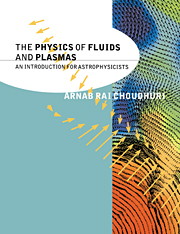Book contents
- Frontmatter
- Contents
- Preface
- Acknowledgements
- Introduction
- Part I Neutral fluids
- Part 2 Plasmas
- 10 Plasma orbit theory
- 11 Dynamics of many charged particles
- 12 Collisionless processes in plasmas
- 13 Collisional processes and the one-fluid model
- 14 Basic magnetohydrodynamics
- 15 Theory of magnetic topologies
- 16 Dynamo theory
- Epilogue
- Appendix A Useful vector relations
- Appendix B Integrals in kinetic theory
- Appendix C Formulae and equations in cylindrical and spherical coordinates
- Appendix D Values of various quantities
- Appendix E Basic parameters pertaining to plasmas
- Suggestions for further reading
- References
- Index
15 - Theory of magnetic topologies
from Part 2 - Plasmas
Published online by Cambridge University Press: 05 June 2012
- Frontmatter
- Contents
- Preface
- Acknowledgements
- Introduction
- Part I Neutral fluids
- Part 2 Plasmas
- 10 Plasma orbit theory
- 11 Dynamics of many charged particles
- 12 Collisionless processes in plasmas
- 13 Collisional processes and the one-fluid model
- 14 Basic magnetohydrodynamics
- 15 Theory of magnetic topologies
- 16 Dynamo theory
- Epilogue
- Appendix A Useful vector relations
- Appendix B Integrals in kinetic theory
- Appendix C Formulae and equations in cylindrical and spherical coordinates
- Appendix D Values of various quantities
- Appendix E Basic parameters pertaining to plasmas
- Suggestions for further reading
- References
- Index
Summary
Introduction
In the previous chapter, we developed MHD following a pattern somewhat similar to the pattern followed earlier while developing hydrodynamics. After presenting the basic equations, we first considered the possibility of static equilibrium, and afterwards waves and instabilities were discussed. Although the mathematical analysis in the presence of a magnetic field becomes much more complicated than the corresponding analysis in the pure hydrodynamic case and consequently our discussions in Chapter 14 were often less complete than the earlier corresponding discussions in the pure hydrodynamic case, we have seen that the basic techniques and the methodology were the same.
We now wish to look at a class of MHD problems loosely called topological problems. Let us first consider a situation of ideal MHD, where we have a magnetofluid of zero resistivity. Then, according to Alfvén's theorem, the magnetic field is completely frozen in the plasma. We have pointed out one important consequence of Alfvén's theorem in §14.2. If two fluid elements lie on a magnetic field line, then they would always lie on one field line. We may have two far-away fluid elements in the ideal magnetofluid connected by a magnetic field line. No matter what happens to the magnetofluid or how it evolves in time, this connectivity between the two far-away fluid elements remains preserved if the resistivity is zero. The preservation of such connectivities may introduce some constraints on the dynamics of the system.
- Type
- Chapter
- Information
- The Physics of Fluids and PlasmasAn Introduction for Astrophysicists, pp. 319 - 339Publisher: Cambridge University PressPrint publication year: 1998



